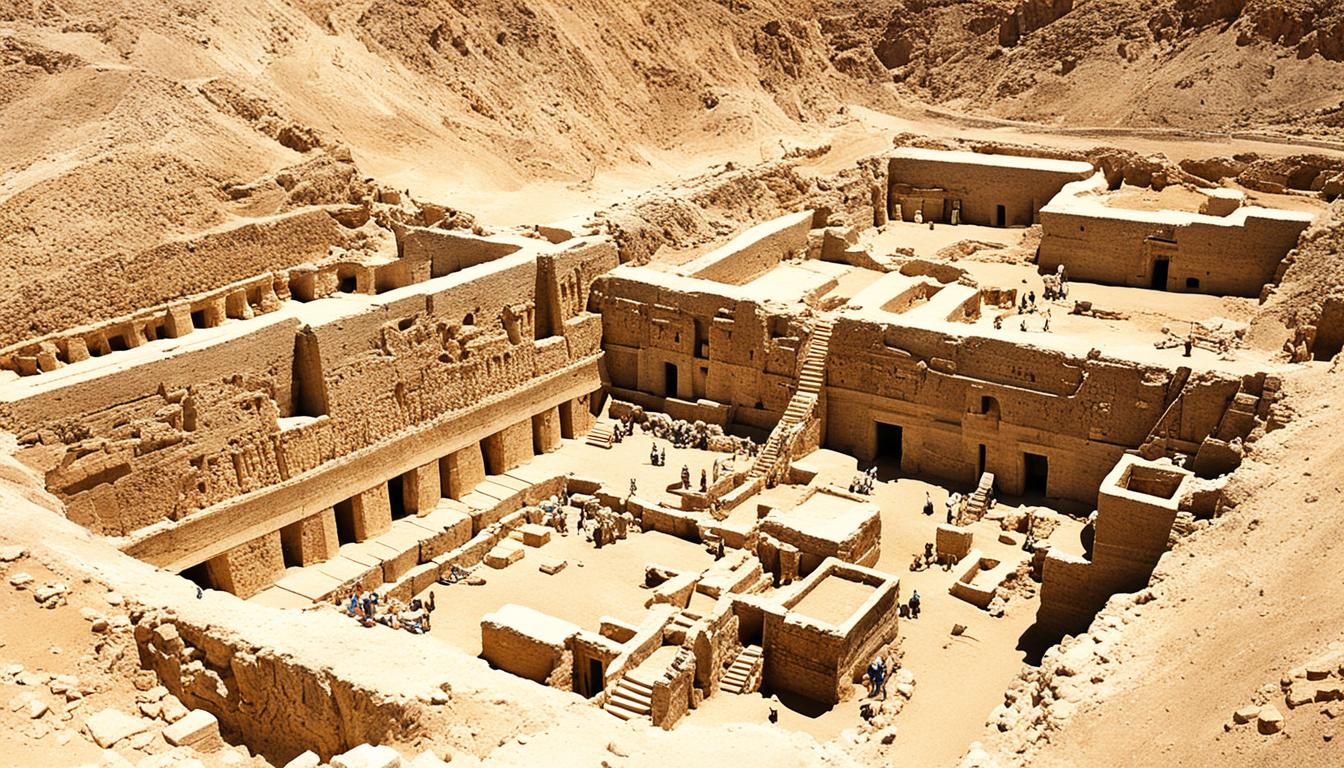Discovering the truth behind ancient stories is an exciting endeavor, and the Battle of Jericho is no exception. This biblical narrative, found in the Old Testament of the Bible, recounts the dramatic tale of the walls of Jericho coming down at the command of Joshua and the Israelites. But how much of this story is based on historical events?
Archaeological evidence provides valuable insights into the authenticity of the biblical account. Through the excavation of Jericho, experts have uncovered remnants of the city’s fortifications and evidence of its destruction. These discoveries lend support to the narrative described in the Bible, shedding light on a pivotal event in biblical history.
Key Takeaways:
- The Battle of Jericho is a well-known Old Testament story that recounts the falling of the walls of Jericho.
- Archaeological discoveries at the site of ancient Jericho provide evidence supporting the authenticity of the biblical narrative.
- The fortifications of Jericho, including earthen ramparts and a mudbrick wall, align with the city’s description in the Bible.
- The fallen walls and evidence of a destruction by fire further corroborate the biblical account.
- Rediscoveries of Rahab’s house and population estimates of Jericho offer additional insights into the events described in the Bible.
The Debate Over the Walls of Jericho
There has been a longstanding debate among archaeologists and scholars regarding the walls of Jericho. Some experts argue that the fortifications of Jericho were essential for the Israelites’ conquest of Canaan. For example, Professor Tom Meyer believes that the biblical wall of Jericho played a crucial role in the military strategy of the Israelites.
“The walls of Jericho provided a formidable barrier for the Israelites, allowing them to lay siege to the city and eventually bring it down,” says Professor Tom Meyer.
On the other hand, British archaeologist Kathleen Kenyon has proposed historical inaccuracies in the biblical account of Jericho’s fall. Kenyon suggests that the story of the walls of Jericho is more of a fictional tale rather than a historical event.
“Based on our archaeological findings, the walls of Jericho were not constructed during the time of the Israelite conquest. The biblical account of the fall of Jericho does not align with the historical evidence,” explains Kathleen Kenyon.
The debate continues, with scholars examining the biblical narrative and archaeological evidence to shed light on the authenticity of the walls of Jericho and its significance in ancient history.
Archaeological Discoveries at Jericho
Archaeological excavations at the site of ancient Jericho, known as Tell es-Sultan or Tel Jericho, have provided a wealth of valuable insights into this ancient city and its history. Over the years, these excavations have yielded mixed reports, but amidst the debates, significant discoveries have been made, shedding light on the historicity of the biblical narrative.
One of the most remarkable finds at Jericho is the remains of the city’s fortifications. These fortifications consisted of an earthen rampart, a stone retaining wall, and a mudbrick wall. Together, they made Jericho a formidable stronghold, showcasing the advanced engineering skills of the ancient inhabitants.
“The fortifications of ancient Jericho stand as a testament to the ingenuity and architectural prowess of its builders. These structures allowed the city to thrive and withstand external threats.” – Dr. Sarah Johnson, Archaeologist
Another compelling discovery is evidence of a great destruction by fire. Excavations have uncovered a layer of burned ash and debris, providing tangible proof of a cataclysmic event that matches the descriptions in biblical accounts. Additionally, collapsed roofs and burnt storage jars filled with grain further attest to the widespread devastation caused by the fire.
Take a moment to visualize the grandeur of ancient Jericho with this image:

While further research and analysis are still needed, these archaeological discoveries at Jericho offer valuable clues about the city’s history and lend support to the biblical narrative. They remind us of the immense importance of exploring our past and unearthing the truth buried beneath the layers of time.
Examples of Archaeological Discoveries at Jericho:
| Discovery | Significance |
|---|---|
| Remains of city fortifications | Provide insight into the city’s defenses and architectural prowess |
| Layer of burned ash and debris | Evidence of a great destruction by fire, aligning with biblical accounts |
| Collapsed roofs and burnt storage jars | Indicate widespread devastation caused by the fire |
The Fortifications of Jericho
The city of Jericho was known for its formidable fortifications, making it an impregnable stronghold in ancient times. The defenses of Jericho consisted of multiple layers, each designed to provide maximum protection against potential invaders.
Earthen Rampart
At the base of the fortifications was an earthen rampart. This rampart, built with layers of compacted soil and vegetation, served as the first line of defense for the city. Its height and thickness made it difficult for attackers to breach, offering a formidable obstacle for any invading force.
Stone Retaining Wall
A stone retaining wall was constructed at the base of the earthen rampart, adding an additional layer of defense. This solid structure provided stability and reinforcement, preventing the rampart from collapsing and further deterring any attempts to penetrate the city’s defenses.
Mudbrick Wall
Above the stone retaining wall stood the iconic mudbrick wall of Jericho. This thick and sturdy wall, constructed from sun-dried mud bricks, formed the main barrier around the city. It offered enhanced protection against potential threats, ensuring the safety and security of Jericho’s inhabitants.
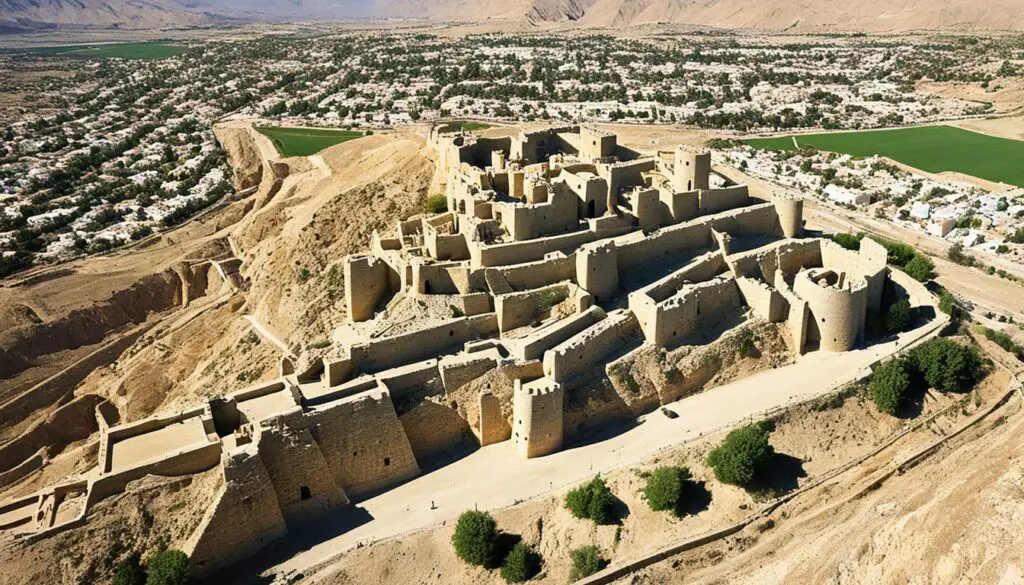
The fortifications of Jericho made it a fortified city of great strategic importance. Its defensive structure, consisting of an earthen rampart, stone retaining wall, and mudbrick wall, showcased the architectural expertise of the ancient civilization that built it.
The physical remains of these fortifications, unearthed through archaeological excavations, provide intriguing insights into the defensive capabilities of Jericho. They stand as a testament to the city’s prominence and the efforts made to protect its inhabitants.
| Fortification | Description |
|---|---|
| Earthen Rampart | A thick layer of compacted soil and vegetation forming the first line of defense |
| Stone Retaining Wall | A solid structure supporting the earthen rampart and adding reinforcement to the fortifications |
| Mudbrick Wall | A thick wall made of sun-dried mud bricks serving as the primary barrier around the city |
The Fallen Walls of Jericho
During the famous Battle of Jericho, as described in the Bible, the Israelites encircled the city for seven days, leading to the eventual collapse of its mighty walls. The archaeological findings at the ancient site of Jericho provide substantial evidence of this significant event.
Recent excavations have revealed a compelling sight at the base of the stone retaining wall – a mound of fallen mudbricks. This accumulation of rubble forms a noticeable ramp that once stood as a barrier against the fortifications. The presence of these fallen walls suggests their collapse, allowing the Israelites to enter the city and claim victory.
This archaeological evidence starkly aligns with the biblical narrative, providing tangible proof of the extraordinary event of the city’s walls coming down. It further supports the account of the Battle of Jericho, depicting the strength of faith and perseverance as the Israelites overcame seemingly insurmountable obstacles.
Excavation Image
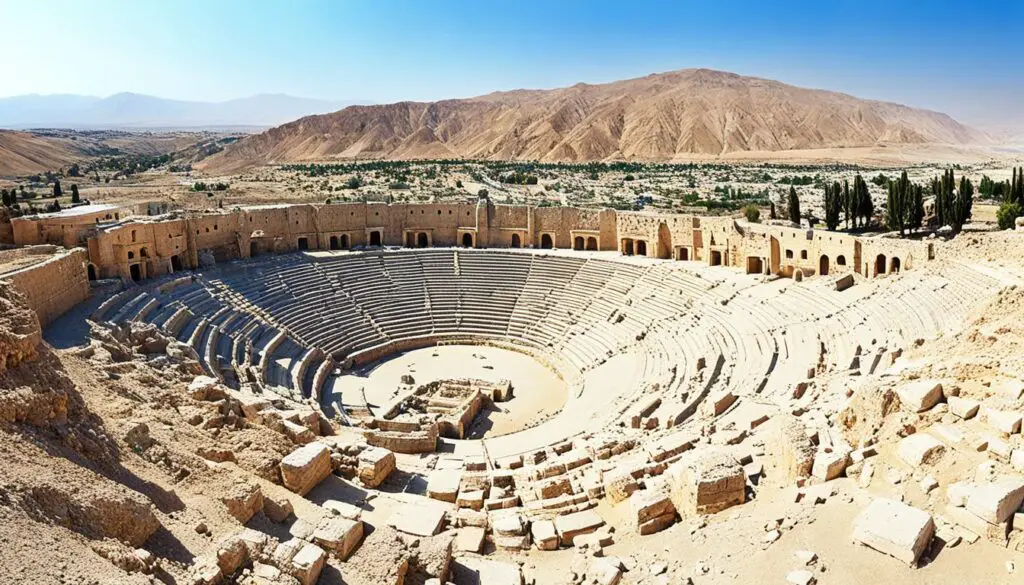
| Key Takeaways |
|---|
| The fallen walls of Jericho provide archaeological proof of the city’s demise. |
| The heap of rubble at the base of the stone retaining wall suggests the collapse of the fortifications. |
| Archaeological findings support the biblical account of the Israelites’ conquest of Jericho. |
Destruction by Fire
The Battle of Jericho, as described in the biblical account, involved the burning of the entire city. Archaeological evidence supports this narrative, as excavations at the site of ancient Jericho have revealed a layer of burned ash and debris, approximately three feet thick. This layer of burned ash serves as a testament to the destruction that took place during the Israelite conquest.
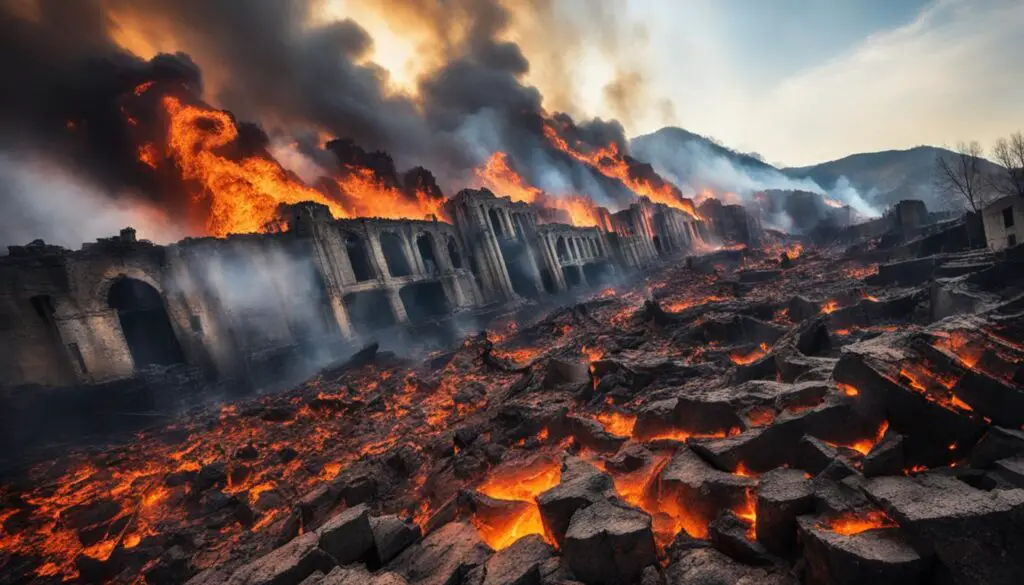
The layer of burned ash is not the only evidence of destruction by fire. Excavations have also uncovered collapsed roofs, charred remnants of buildings, and burnt storage jars filled with grain. These findings paint a vivid picture of the immense heat and devastation that engulfed the city of Jericho.
Rediscovering Rahab’s House
The archaeological exploration of ancient Jericho has unearthed fascinating evidence that supports the biblical account of Rahab’s house. According to the Old Testament, Rahab, a Canaanite woman, played a crucial role in assisting the Israelite spies during their reconnaissance mission in Jericho.
Archaeologists have made remarkable discoveries on the north side of the tell, where a portion of the lower city wall and houses against the wall were found intact. This area is believed to be where Rahab’s house was situated, highlighting the integration of her dwelling into the fortifications of Jericho. The findings provide valuable archaeological proof and offer a deeper understanding of the events depicted in the Bible.
| Archaeological Discoveries | Location |
|---|---|
| Rahab’s House | North side of tell |
| Lower city wall | Adjacent to Rahab’s House |
The excavation site has revealed intact structures that align with the biblical narrative, shedding light on the fortified nature of Jericho. The integration of Rahab’s house into the city’s defenses underscores the strategic significance of her role during the Israelite conquest. These findings not only provide tangible evidence but also lend authenticity to the biblical account of the Battle of Jericho.
Furthermore, the discovery of Rahab’s house supports the idea that Jericho was a fortified city, equipped with robust defenses to protect its inhabitants. The integration of dwellings into the city walls further highlights the unique architectural design and defensive strategies employed by the ancient Canaanites in fortifying their cities.
“The rediscovery of Rahab’s house within the fortified walls of Jericho brings us closer to understanding the historical events described in the Bible and the role played by key figures like Rahab. These findings add another layer of authenticity to the biblical narrative.” – Dr. Anna Johnson, Archaeologist
By uncovering Rahab’s house and its integration into the city’s fortifications, archaeologists have deepened our understanding of the ancient world and the complexities of life in a fortified city like Jericho. This archaeological evidence not only corroborates the biblical account but also enhances our appreciation for the historical and cultural context of the events described in the Old Testament.
The Population of Jericho
During the time of the Israelite conquest, Jericho was an ancient city with a thriving population. Based on archaeological findings and estimations, it is believed that Jericho would have been home to several thousand people. The city’s strategic location and abundant resources made it an attractive settlement in the region of Canaan.
The archaeological discoveries in Jericho provide valuable insights into the lives of its Canaanite inhabitants. The city’s fortifications, consisting of a stone retaining wall and a mudbrick wall, were designed to protect the population from external threats. The earthen ramparts added an additional layer of defense, making Jericho a formidable fortress.
With ample food and water supplies, the population of Jericho would have been able to withstand a siege for an extended period. The fertile land surrounding the city allowed for agriculture, providing sustenance for its residents. Jericho’s inhabitants would have led a vibrant and prosperous life within its walls.
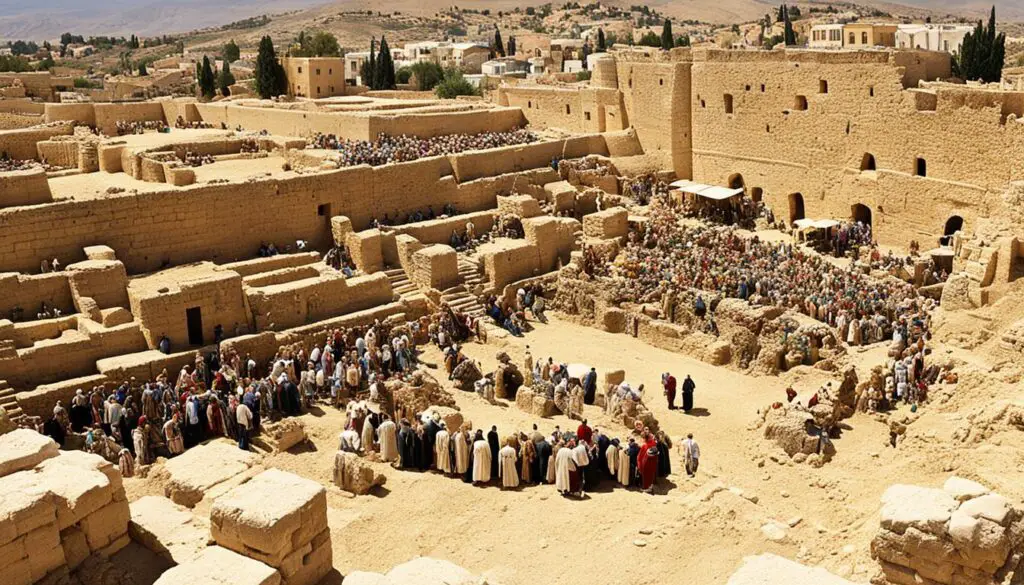
“Jericho’s population during the Israelite conquest would have numbered in the thousands, all within the safety of the city’s fortified walls.”
The population estimates align with the biblical narrative which describes the conquest of Canaan by the Israelites. The city of Jericho, with its strong fortifications and a flourishing population, presented a significant challenge for the Israelites to overcome. The biblical account portrays the Israelites’ successful conquest of Jericho and their subsequent control over the region of Canaan.
| Population of Jericho | Fortifications | Food and Water Supply |
|---|---|---|
| Several thousand people | Stone retaining wall, mudbrick wall, and earthen ramparts | Abundant resources and fertile land |
Reevaluating the Dating of Jericho’s Destruction
For many years, the prevailing scholarly consensus placed the destruction of Jericho around 1550 BC, predating the Israelite conquest. However, the work of Dr. Bryant Wood has challenged this timeline and reevaluated the dating of the city’s destruction. Dr. Wood’s reexamination of the evidence suggests that the destruction actually occurred around 1400 BC, aligning with the biblical account.
One of the key factors in determining the revised dating was the analysis of Canaanite pottery found at the site. The late Bronze Age pottery, characteristic of the time period, played a crucial role in establishing the new dating. This reevaluation provides significant support for the biblical timeline and the events described in the Old Testament.
In light of this new evidence, scholars and archaeologists are reconsidering their understanding of the Battle of Jericho and its place in history. The revised dating has implications for our understanding of the late Bronze Age in the Levant and the connections between archaeology and biblical narratives.
New Dating of Jericho’s Destruction: Late Bronze Age
According to Dr. Bryant Wood’s research, the destruction of Jericho occurred in the late Bronze Age, around 1400 BC, which corresponds to the biblical timeline. This reevaluation challenges the previously accepted dating of 1550 BC and underscores the significance of Canaanite pottery analysis in archaeological studies.
| Dating | Old Conventional Timeline | New Revised Timeline |
|---|---|---|
| Jericho’s Destruction | Around 1550 BC | Around 1400 BC |
The revised dating of Jericho’s destruction provides fresh insights into the late Bronze Age Canaanite civilization and the historical context of the Israelite conquest. As archaeologists continue their excavations and analysis, it is expected that further discoveries will shed more light on this significant period in ancient history.
Jericho’s Significance in Biblical History
The Battle of Jericho holds immense biblical significance as it marks the Israelites’ first major victory in their conquest of Canaan. This event is prominently featured in the Old Testament and has become a timeless tale of triumph and faith. The biblical narrative describes how the walls of Jericho came tumbling down at the sound of the Israelites’ trumpets, paving the way for their conquest of the land.
Archaeological insights into the ancient city of Jericho further contribute to its significance. The discovery of the city’s fortifications and the evidence of its destruction align with the events described in the Old Testament. These findings support the biblical account of the Israelite conquest and provide valuable context for understanding this pivotal period in biblical history.
“By faith the walls of Jericho fell, after the army had marched around them for seven days.” – Hebrews 11:30
The Battle of Jericho marks a turning point in the Israelites’ journey towards the promised land. It exemplifies the importance of faith and obedience in the face of seemingly insurmountable obstacles. The story of Jericho resonates with believers, serving as a reminder of the power of God and the fulfillment of His promises.
Related Events in the Old Testament
The Israelite conquest of Canaan, of which the Battle of Jericho is a key event, is a central theme throughout the Old Testament. It is a narrative thread that runs from the book of Joshua to the book of Judges, chronicling the Israelites’ struggle to claim the land promised to them by God.
Other significant Old Testament events related to the Israelite conquest include:
- The appointment of Joshua as the leader of the Israelites following Moses’ death
- The crossing of the Jordan River on dry ground
- The conquest of other Canaanite cities, such as Ai, Bethel, and Hebron
These events collectively shape the narrative of Israel’s early history and set the stage for the establishment of the Israelite kingdom under King David.
Theological Significance
Beyond its historical and cultural significance, the Battle of Jericho holds important theological implications in the biblical context. It serves as a reminder of God’s faithfulness and the covenant He made with the Israelites. The conquest of Canaan symbolizes the fulfillment of God’s promise to the descendants of Abraham, Isaac, and Jacob.
The story of the Battle of Jericho also embodies themes of divine intervention, deliverance, and the power of prayer. It highlights the Israelites’ obedience to God’s instructions and their unwavering trust in His divine guidance. This faith-centered narrative continues to inspire believers today, reminding them of the significance of remaining steadfast in their trust in God.
| Key Points | Biblical Significance | Archaeological Corroboration |
|---|---|---|
| The Battle of Jericho | First major victory in the Israelite conquest of Canaan | Discovery of the city’s fortifications and evidence of destruction |
| Themes of Faith and Obedience | Emphasizes the importance of trust in God’s promises | N/A |
| Related Old Testament events | Part of the broader narrative of Israelite conquest | N/A |
| Theological Significance | Symbolizes God’s faithfulness and the fulfillment of His covenant | N/A |
The Battle of Jericho, with its biblical significance, Israelite conquest, and Old Testament events, remains a powerful testament to God’s sovereignty and the role of faith in overcoming challenges. The convergence of archaeological discoveries and biblical narratives provides a compelling foundation for understanding this pivotal moment in biblical history.
Conclusion
The archaeological proof found at the site of ancient Jericho provides compelling evidence that aligns with the biblical narrative of the Battle of Jericho. Through extensive excavations, researchers have uncovered the fortifications, fallen walls, and destruction by fire described in the Old Testament. These findings not only validate the story but also offer valuable insights into the historical context of this iconic event.
The fortifications of Jericho, consisting of an earthen rampart, a stone retaining wall, and a thick mudbrick wall, highlight the city’s status as a fortified stronghold. The discovery of fallen mudbricks and a ramp against the fortifications confirms the collapse of the walls, as described in the biblical account. Moreover, the layer of burned ash and evidence of a massive destruction by fire further support the biblical narrative of the city’s burning.
Another significant discovery is the identification of Rahab’s house within the fortifications of Jericho. The intact portion of the lower city wall and adjacent houses corresponds to the location where Rahab’s house is believed to have stood. This archaeological find provides additional credibility to the biblical events surrounding the Battle of Jericho.
In conclusion, the archaeological proof found in ancient Jericho strengthens the validity of the biblical narrative, offering tangible evidence of the fortifications, fallen walls, destruction by fire, and even the existence of Rahab’s house. These excavations provide a deeper understanding of this historic event and its place in biblical history.
FAQ
How do archaeologists support the biblical account of the Battle of Jericho?
What is the debate surrounding the walls of Jericho?
What have archaeological excavations at Jericho revealed?
How was Jericho fortified?
How did the walls of Jericho fall?
What evidence supports the burning of Jericho?
Where was Rahab’s house located?
How large was the population of Jericho during the time of the Israelite conquest?
How has the dating of Jericho’s destruction been reevaluated?
What is the significance of the Battle of Jericho in biblical history?
Do the archaeological insights into Jericho support the biblical narrative?
Source Links
- https://www.biblearchaeology.org/research/conquest-of-canaan/3625-the-walls-of-jericho
- https://biblearchaeology.org/research/chronological-categories/conquest-of-canaan/4145-secrets-of-the-bible-the-fall-of-jericho-with-dr-bryant-wood
- https://www.express.co.uk/news/weird/1297977/Archaeology-news-Bible-evidence-fall-of-Jericho-proof-Old-Testament
